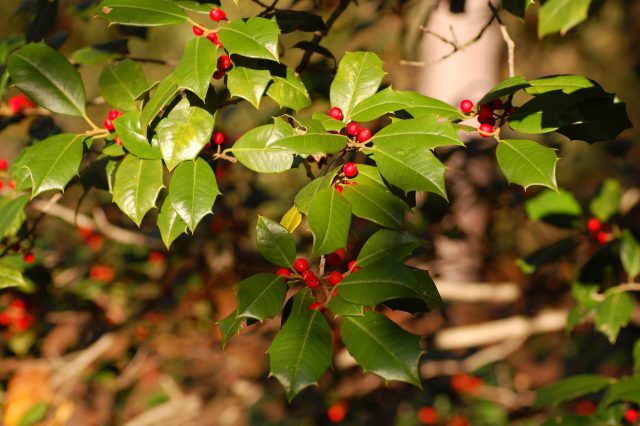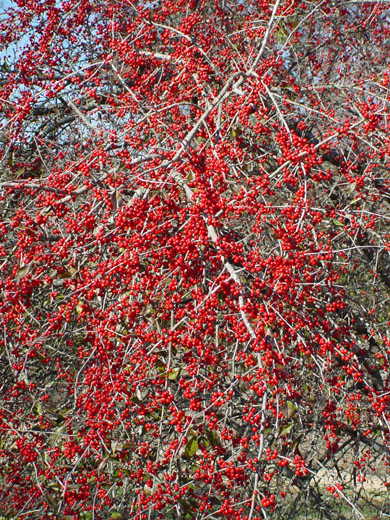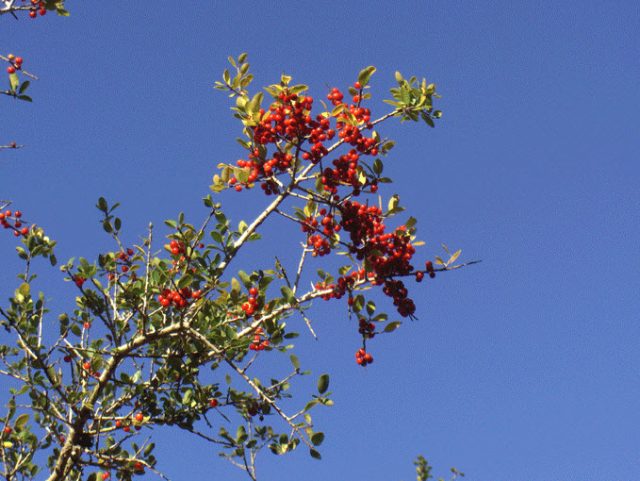
This tree greeted the Pilgrims when they arrived just before Christmas Day in 1620. American Holly is the quintessential Christmas greenery! Wikimedia Commons photo.
23 Dec 2016 – Deck the Halls with Boughs of Holly
Yaupon Holly, that is. Or, just simply, Yaupon, as it is known to most of us. What is Yaupon? Is it the same thing as the holly of Christmas card fame?
Yes, Yaupon is in the same genus as several other species of holly. Yaupon Holly (Ilex vomitoria) is a cousin of the American Holly (Ilex opaca) of the Eastern United States.
Just days before Christmas in 1620, when the Pilgrims landed on the coast of Massachusetts, they saw the welcome sight of American Holly trees in full fruit. The red berries and evergreen, glossy leaves of this New World holly reminded them of the English Holly (Ilex aquifolium), a symbol of Christmas for centuries in England and Europe. It must have seemed like an omen of good fortune to them. Since then American Holly has been one of the more popular trees in the United States, particularly in the Eastern part of the country. Not only is it an iconic part of Christmas decorations, it is also a beautiful landscape plant.
Ilex opaca and Ilex vomitoria have overlapping ranges. Both grow well in the sandy, slightly acid soils of the American southeast. The tree-like American Holly grows from as far north as coastal Massachusetts and as far south as central Florida and westward to East Texas. Yaupon is shrubbier and although it grows over much of the same area, its range extends deeper into Texas.

Possum Haw is a deciduous version of Yaupon Holly. It loses its leaves by mid-winter and the silvery twigs loaded with berries produce a beautiful specimen tree. Possum Haw even grows
Understandably, settlers moving into East Texas were pleased to see American Holly trees. However, as they travelled out of the Big Thicket and into the Post Oak Savannah of central Texas, the holly trees disappeared. The smaller cousin, Yaupon, became the “go-to” Christmas decoration in these areas.

Yaupon Holly is a cousin of the American Holly of Christmas card fame. With its smaller non-prickly leaves and bright red berries, it is a nice Christmas decoration for us in this part of Texas. It grows in the eastern half of Bee County. Wikimedia Commons photo.
With its vibrant red berries and dark green leaves, Yaupon was a perfect substitute. In fact, its leaves are not as prickly as American Holly, so it may have seemed even better! Yaupon likes well-drained sandy soils and coastal pine forests. It is an abundant native shrub inland as far as central Texas. It meets its match, however, when you get into South Texas. It does not thrive in our alkaline caliche soils. You may have noticed there are very few Ilex vomitoria occurring naturally in our area. Its range ends a few miles west of Blanco Creek on the edge of Bee County.
In the rockier western portion of south Texas we have another red-berried evergreen shrub: Desert Yaupon. It superficially resembles Yaupon, but is not an Ilex at all. Desert Yaupon (Schaefferia cuneifolia) has pale green leaves that stay on the bush a long time, but are not truly evergreen. Its dense, rigid branches are often spiny and its fruits are more orange than red. It is great for rock gardens and xeriscaping. Birds and wildlife feed on the berries. It is thus valuable, but I cannot see it becoming a Christmas decoration any time soon.
Possum Haw is another story. Possum Haw is a holly (Ilex decidua), and as its name suggests, it loses its leaves in winter. What is left is a graceful, silvery-gray branched tree loaded with red berries. Possum Haw’s native range extends inland especially along river drainages. It tolerates alkaline soil and is a popular landscape tree well into the Hill Country. I have found lovely specimens, presumably natives, of this holly in Goliad State Park. In the landscape or as cut branches, this deciduous holly makes a nice Christmas/Winter decoration.
About those red berries on the Ilex hollies: They are not really berries, but drupes. Inside each drupe are 4 to 8 tiny stone-like seeds. The juicy pulp and the protein-rich seeds are excellent food for quail, songbirds, opossums, raccoons, and other small mammals. The “berries” seem to be more appealing to these animals after the fruit has undergone several freeze-thaw cycles.
Although Possum Haw and Yaupon are native to large portions of our region, I encourage you not to collect boughs and boughs of the wild trees as seasonal décor. Better to plant a few hollies in your yard for winter cheer. Please note that the male and female flowers usually occur on separate trees, and only the females produce the red berries. Benny J. Simpson, in his A Field Guide to Texas Trees (1999) notes that male plants outnumber female plants ten to one. Most nursery- grown plants are female clones to guarantee customer satisfaction. Still it might be advisable to plant a male nearby to assure pollination.
If you do harvest branches of Yaupon or Possum Haw, please do so responsibly. Consider the cuts to be pruning, not hacking apart, the tree. Of course, you should have permission to do so on private land. Remember, too, that the tree with the berries is a female, and they are in shorter supply than the male trees. Every berry you harvest contains four or more seeds that will not get a chance to grow into new trees.
Oh, about Yaupon’s name: Ilex vomitoria. How did that come about? Wikipedia states that Native Americans made a tea, or “black drink” out of yaupon leaves and stems. It was partaken by males as part of a purification ritual that involved vomiting. Europeans observing this mistakenly attributed the vomiting to the yaupon. However, other herbs and roots may have been included that induced vomiting. Ilex vomitoria, like the related yerba mate and guayusa plants of South America, contains caffeine and theobromine as its active ingredients. Perhaps it is time that Yaupon got a new scientific name!
If you would like to offer comments, please click through to the discussion page
